Paw Prints: The Diversity of Cats in Japanese Art
From cute and exotic pets to monstrous, otherworldly creatures, cats in Japanese art appear in various forms and contexts. Let’s delve into the...
Iolanda Munck 21 January 2025
As a proud owner of Pimpa the Cat, the laziest cat in the world, I do what I must do to spread all that is about cats. I have collected 15 of the most purrific cats in art history that every cat lover would want to put on their wall. In some of these pieces, the cats play the central role while in others they are just there, but we all know that in reality cats always play the main role because they rule the world. Enjoy!
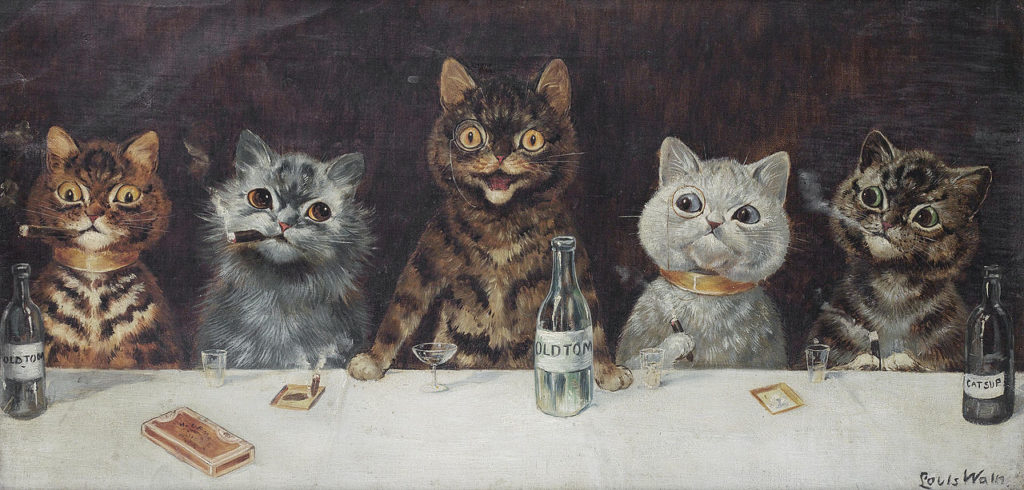
Louis Wain and his cats deserve their own article! Wain was one of the most popular English illustrators. Born in 1860, he became famous for his anthropomorphic portrayals of cats. As the English writer H.G. Wells remarked, “he invented a cat style, a cat society, a whole cat world.” The thing is that Wain suffered from a mental illness and probably had schizophrenia which might have caused his obsession with cats.
He became known as a leading authority on all things cats and was elected president of the National Cat Club. Also, he judged cat competitions and was involved in several animal charities. He worked for nearly 30 years, sometimes producing as many as several hundred drawings a year, which amuse cat and art lovers to this day.
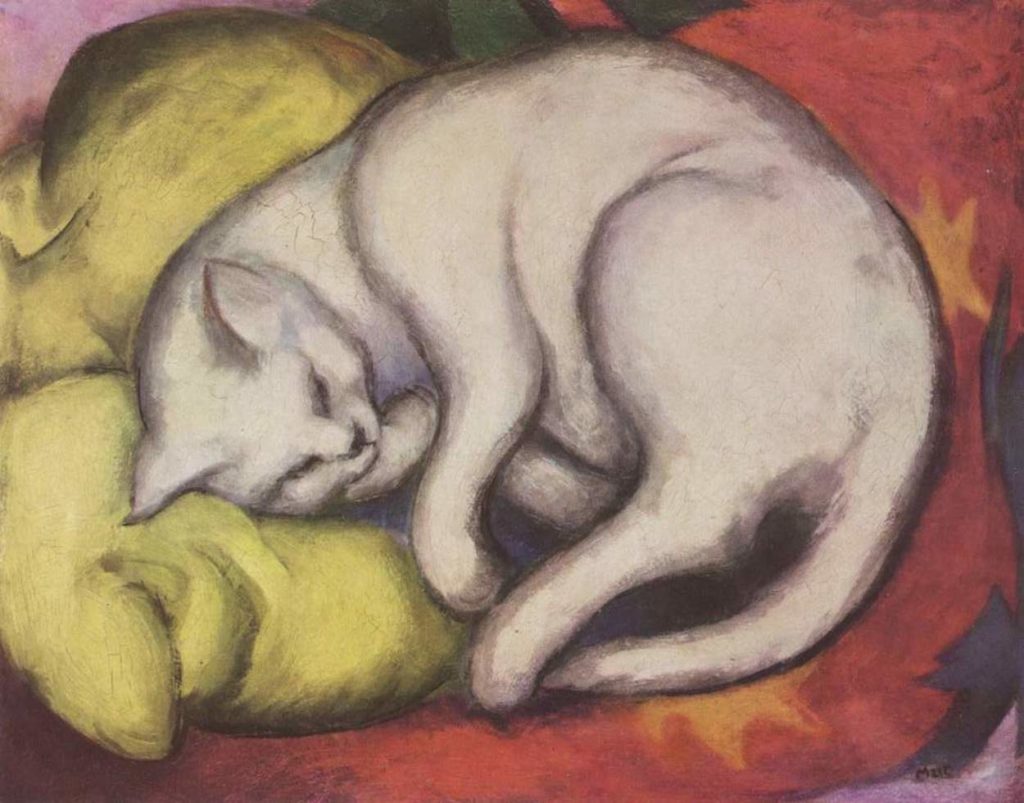





Franz Marc is known for his images of brilliantly colored animals – horses, dogs, and of course, cats. In 1911–1912 Marc displayed his works in Munich. His paintings of cats illustrate the animals in their natural state of sleeping or grooming. Some of his famous cat paintings show cats on a pillow, two cats blue and yellow, cats in a basket, and cats on a red cloth. For him, animals were the ideal symbol of purity, truth, and beauty. Also, he believed in the symbolism of colors – blue meant spirituality and masculinity, yellow feminine happiness, and red represented violence.
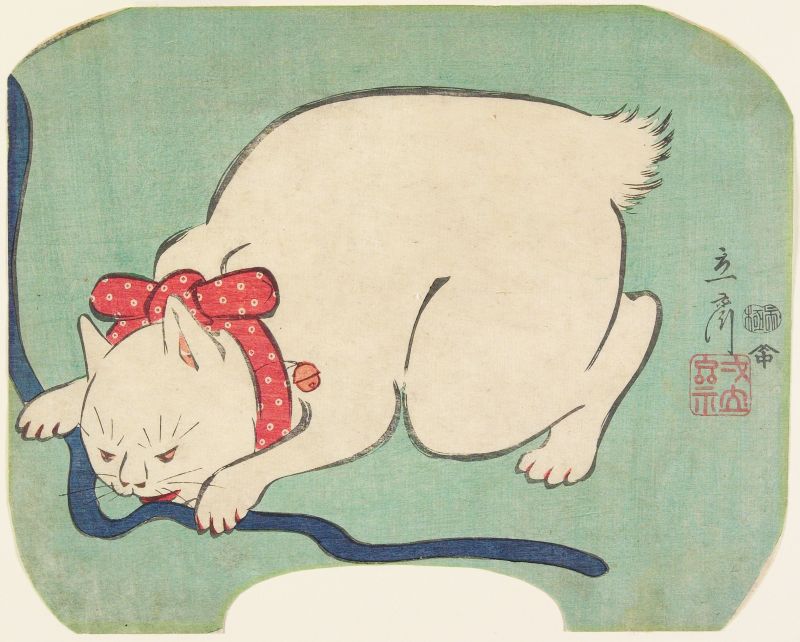





This is a rather unusual fan print designed by Hiroshige II who often closely followed the style and designs of his immensely successful mentor (who was, of course, also called Hiroshige). This print reflects Hiroshige II’s own unique approach. It shows the artist’s close observation of a house cat, depicted in a bold and minimal manner. This cute and chubby, white bobtail cat is biting a blue string. With hind legs braced against the ground, he appears ready to pounce. If you are a cat owner you know this cat’s face very well!
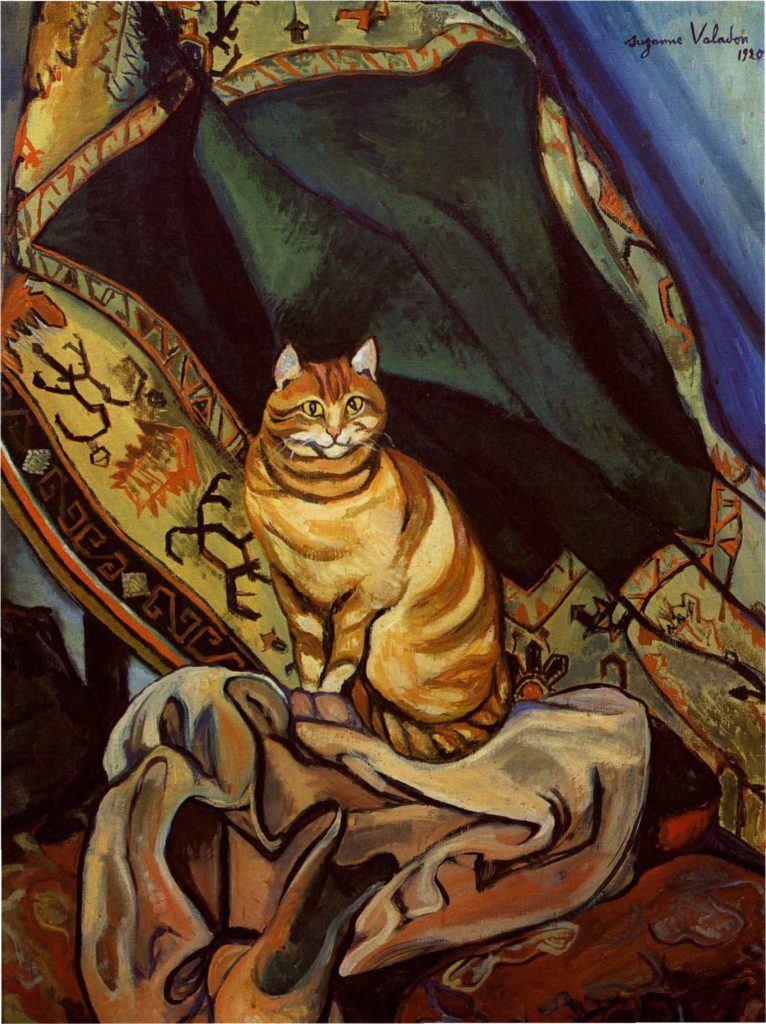





Suzanne Valadon was a French painter and model of artists. In 1894 she became the first woman painter admitted to the Société Nationale des Beaux-Arts. Valadon painted still lifes, portraits, flowers, and landscapes that are noted for their strong composition and vibrant colors. She was, however, best known for her candid female nudes that depict women’s bodies from a woman’s perspective. She was also a cat lover and often painted her cats, especially her favorite, the chubby Raminou.
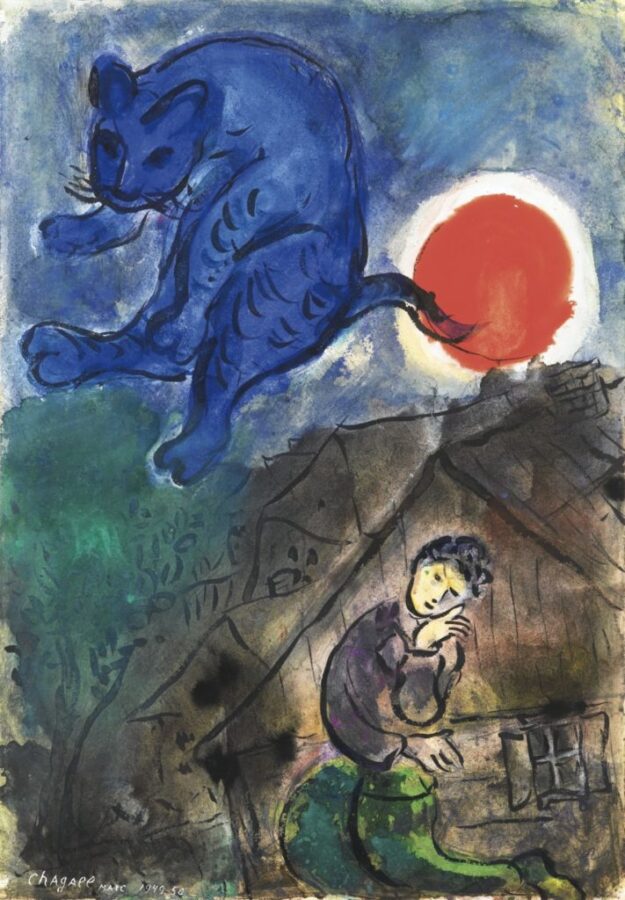





Known as a pioneer of modernism and a major Jewish artist, Marc Chagall experienced modernism’s “golden age” in Paris, where he synthesized the art forms of Cubism, Symbolism, Fauvism and Surrealism. Throughout his long life, he used typical motifs and subjects in most of his work: village scenes, peasant life, and intimate views of the small world of the Jewish village, all presented in a dreamy, unreal manner. Cats often helped emphasize the fantastic character of his paintings and played a major part in many of them. They are usually the companions of the figures he painted – poets, musicians, or women like we see in the painting above.
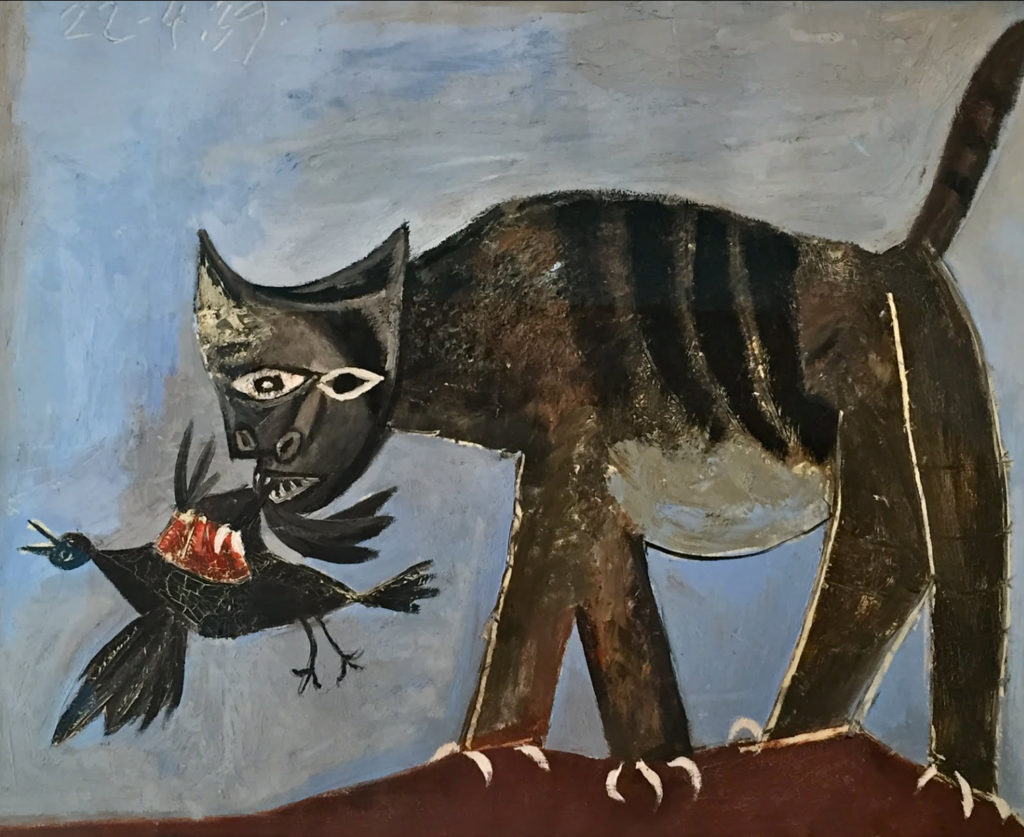





Picasso’s Cat Catching a Bird was created in a couple of versions in 1939 – the year of the outbreak of the war. As Picasso himself recalled, “The subject obsessed me, I don’t know why”. The bird struggles desperately to free itself from its tormentor’s hold. The neutrality of the background does nothing to relieve the horror of the scene. It is an image of everyday life blown up to apocalyptic proportions. The cat is postponing the killing of the bird for as long as possible – the longer he does it, the longer he is in absolute power.
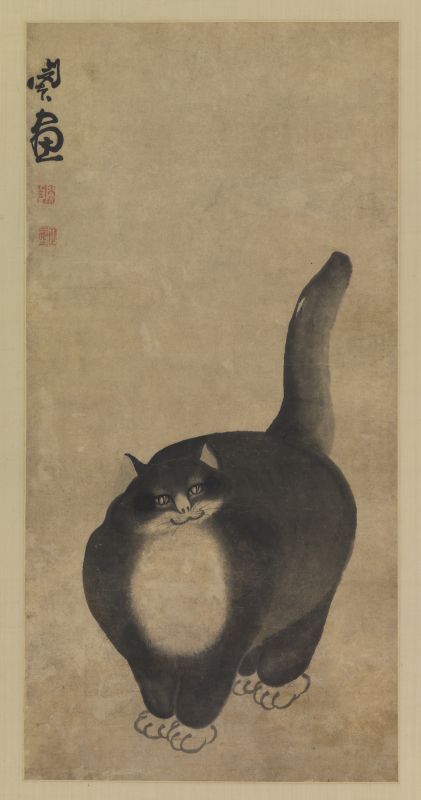





Picasso’s cat was a cruel one – time for a smiling one! Min Zhen was a Chinese painter and seal carver born in Nanchang, Jiangxi, who spent most of his life in the Chinese city of Hubei. He was noted for painting human figures and occasionally doing finger painting. He was orphaned at an early age and is sometimes associated with the Eight Eccentrics of Yangzhou, which is the name for a group of eight Chinese painters active in the 18th century who were known in the Qing Dynasty for rejecting orthodox ideas about painting in favor of a style they deemed expressive and individualist.
It was hard to find any information about this gorgeous chonky cat, but maybe no more comments are needed here. He has just eaten all the cat food in the world and is happy now.
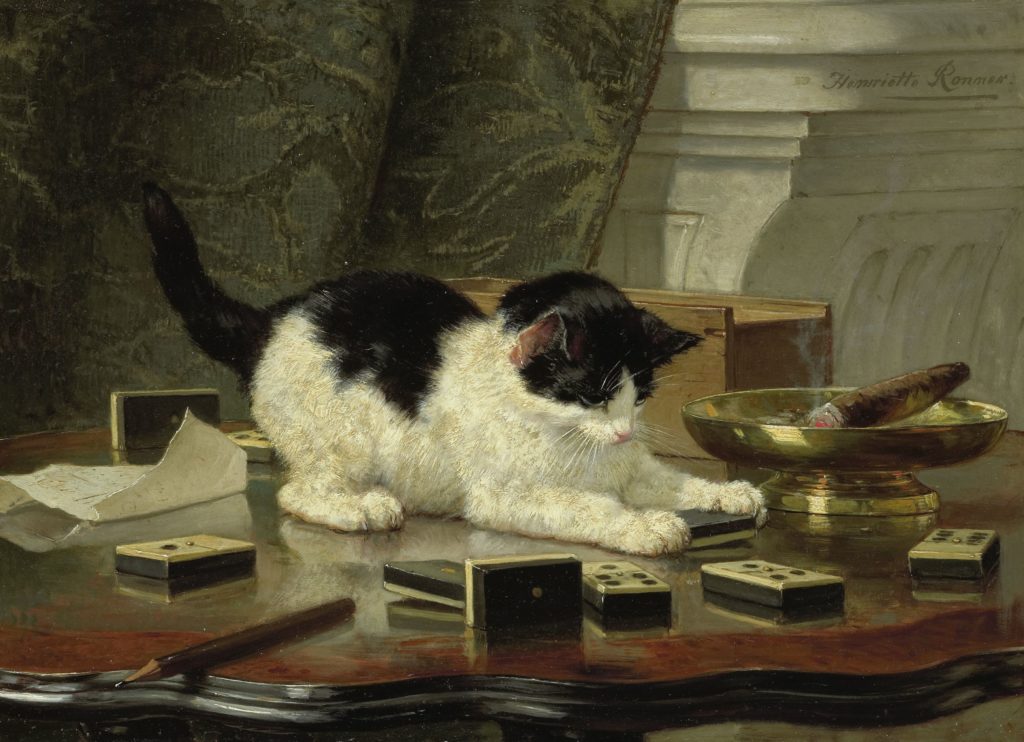





Henriëtte Ronner-Knip was born in Amsterdam into a family of painters. She is well known for her paintings of domestic pets, primarily cats. Pet paintings were popular with the wealthy bourgeois in the Victorian era and her many paintings of cats getting into mischief in domestic scenes proved to be favorites.
Mostly sentimental portrayals, her paintings rarely offer any metaphorical meanings and are focused only on the cats themselves. She studied her cat subjects avidly and with sincerity. She even went so far as to construct a specially built glass-fronted studio in which her cats could freely scamper about, sleep, and get into the types of trouble that only cats can get themselves into.






Bart van der Leck is primarily known as the co-founder of the magazine De Stijl. In 1916, like Piet Mondrian, he opted for radical abstraction in his work and used the primary colors of red, yellow, and blue. That choice was preceded by a quest for a new visual idiom. The classical Egyptian art in the Louvre impressed him during a visit to Paris. Inspired by this, he developed a style with highly simplified forms and sober colors. Consequently in The Cat, Van der Leck depicted the animal both from the side and in profile and used only black, white, red, and orange.
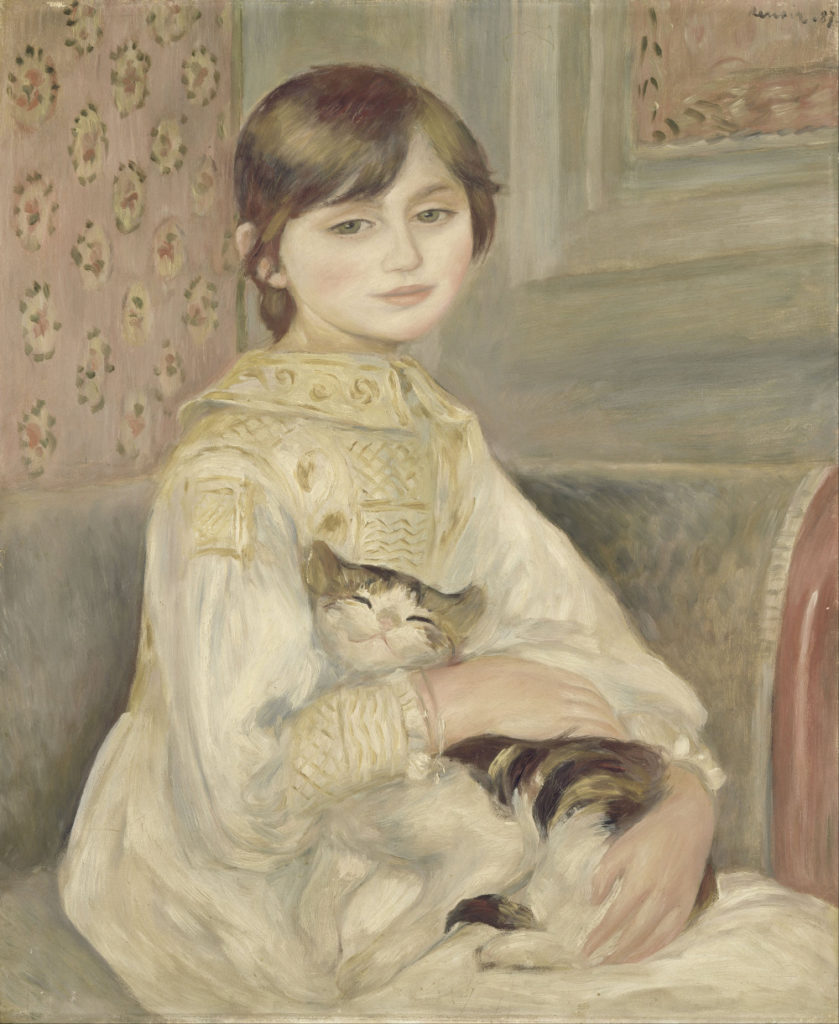





Berthe Morisot and her husband Eugène Manet, brother of the painter, had known Pierre-Auguste Renoir for many years. The Manets’ admiration for the painter’s talent convinced them, in 1887, to commission a portrait of their daughter Julie. The cat is here only the addition, but such a sweet one! Not to mention that it looks much happier than little Julie. Maybe she didn’t like Renoir’s paintings, just like some American art aficionados over 100 years later.
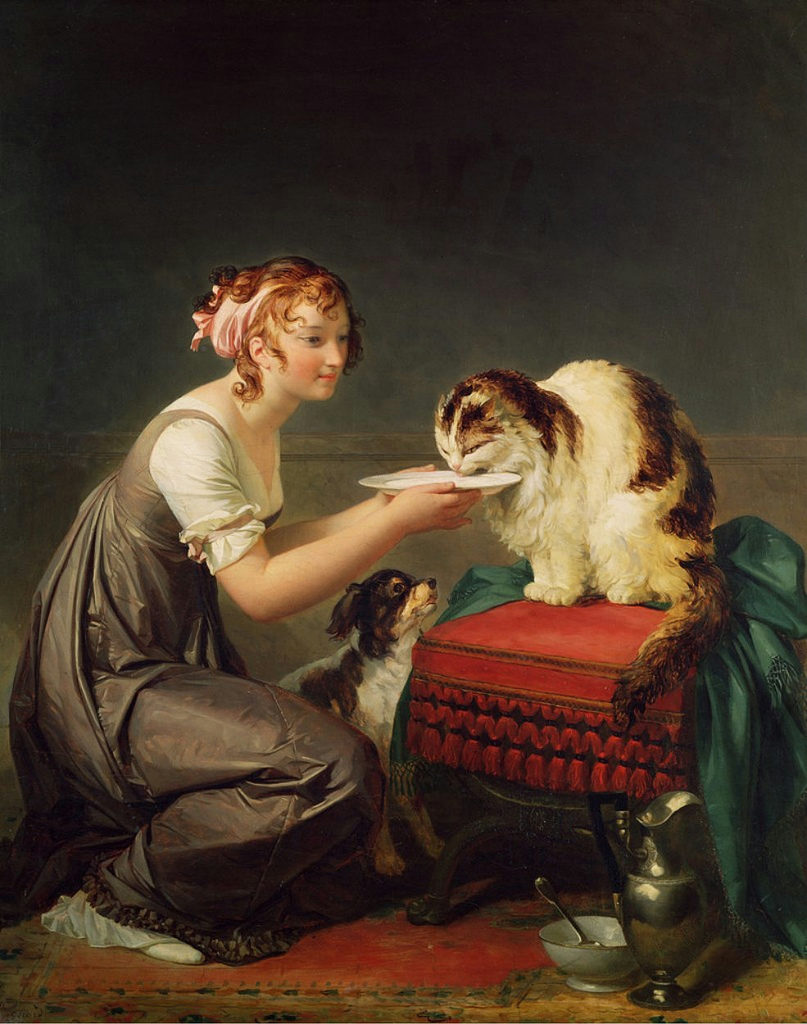





This is how my cat looks when I give him food. Marguerite Gérard was famous for producing oil paintings and etchings under her brother-in-law, the great Jean-Honoré Fragonard. Perhaps he convinced her to add cats to her compositions as he was also famous for doing that. As a genre artist, Gérard focused on portraying scenes of intimate domestic life. However, unlike other female painters who liked to refer to classical antiquity, Marguerite Gérard often used costumes and settings from a few centuries earlier. Many of her paintings illustrate the experiences of motherhood and childhood within the household, and several emphasize the importance of music and female companionship. Cat companionship is equally important, as we can see in this painting.
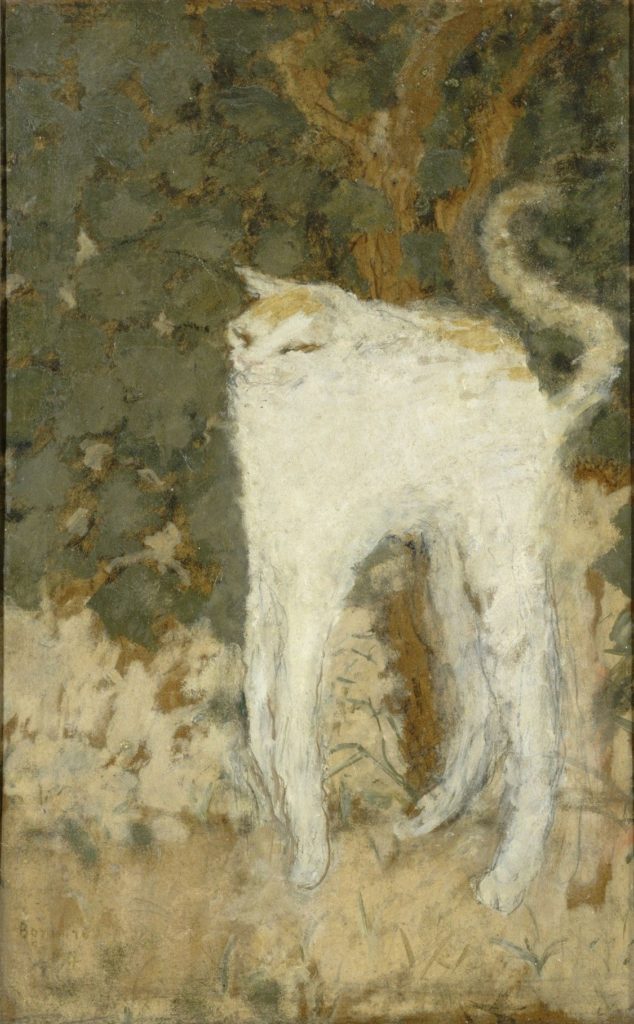





Here, Pierre Bonnard used distortion to create a humorous image of this cat arching its back. The painter spent a long time deciding on the shape and the position of the paws, as can be seen in the preparatory drawings. Japanese inspiration can be found in the bold, asymmetric composition as well as in the choice of subject – one that was very popular in the prints that Bonnard was so fond of. Both Hokusai and Kuniyoshi in particular, whose work you can also spot in this article, had painted cats. Throughout his work, Bonnard produced innumerable paintings that featured cats, sometimes as a simple detail, visible to a greater or lesser degree, sometimes, like The White Cat, as the central subject.
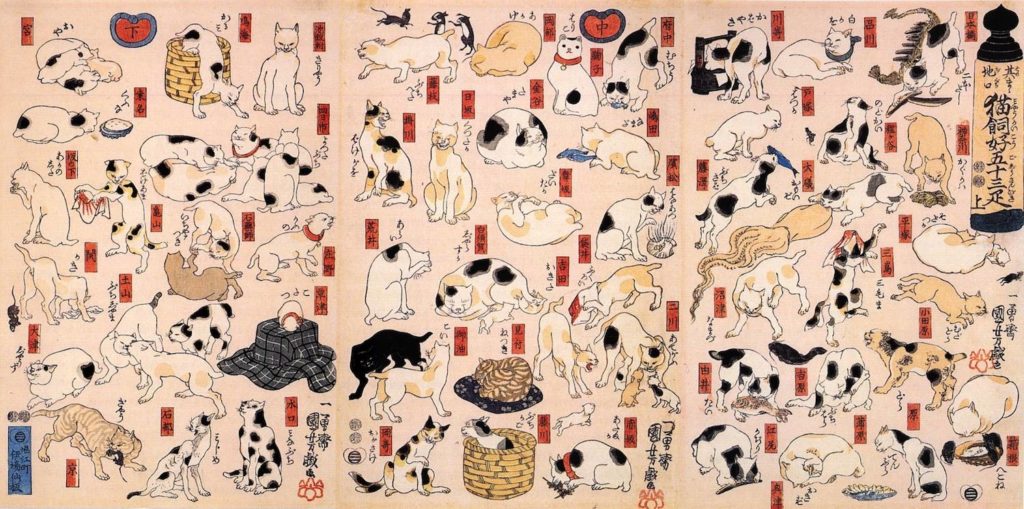





55 cats appear in this triptych print by the Japanese illustrator Utagawa Kuniyoshi. One of them crawls out of a basket, a few catch rats, others eat fish. Kuniyoshi loved cats. When he became a teacher, his students noted that his studio was overrun by them. His fondness for felines crept into his work and they appear in many of his finest prints. Sometimes they appear as characters from well-known stories, other times they are beautifully expressive studies. Often Kuniyoshi would depict cats in a fully anthropomorphic form, as the later Louis Wain.
Cats Suggested as the Fifty-three Stations of the Tōkaidō is a fun spoof on Hiroshige’s The Fifty-three Stations of the Tōkaidō which was the bestselling collection in the history of ukiyo-e. The Tōkaidō – or “Eastern Sea Road” – had 53 different post stations along its route and these provided stables, food, and lodgings for travelers. Kuniyoshi decided to show these stations through cat puns. For example, the 41st station of the Tōkaidō is called Miya. This name sounds somewhat like the Japanese word oya (親) which means “parent”. For this reason, the station is depicted as two kittens with their mother.
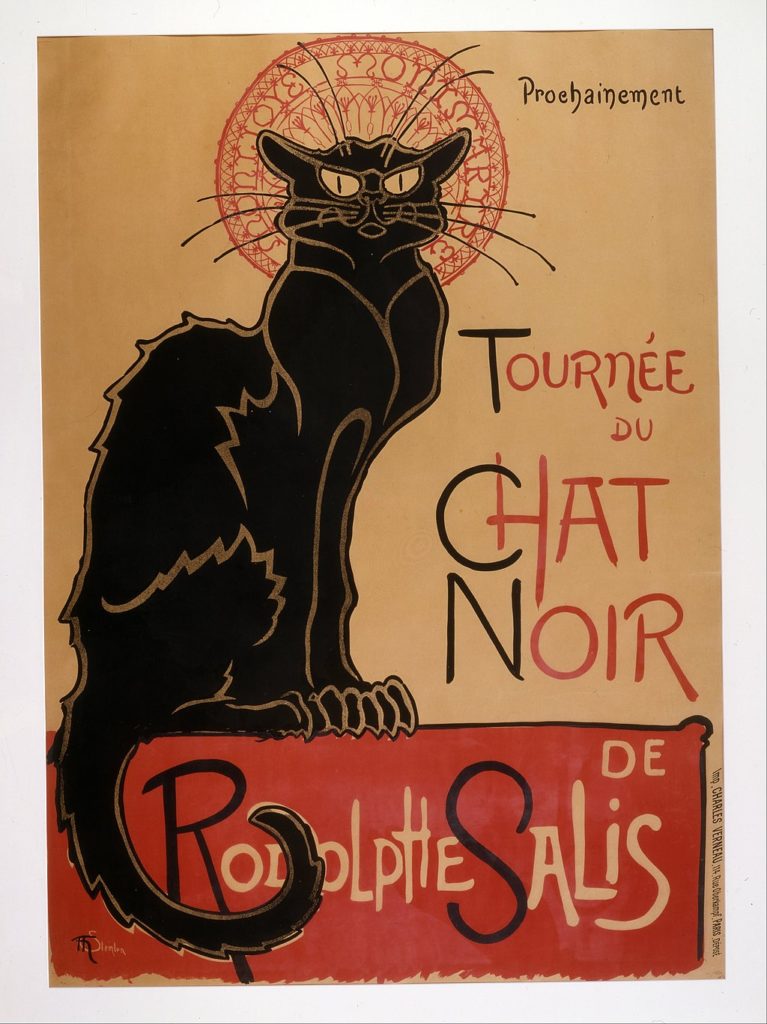





Le Chat Noir was a 19th-century entertainment establishment in the bohemian Montmartre district of Paris. It opened on 18 November 1881 at 84 Boulevard de Rochechouart by the impresario Rodolphe Salis and closed in 1897 not long after Salis’ death. It is believed to be the first modern cabaret: a nightclub where the patrons sat at tables and drank alcoholic beverages while being entertained by a variety show on stage.
This iconic Théophile Steinlen poster advertises a nightclub that in its heyday was partly an artist’s salon and partly a rowdy music hall. From 1882 to 1895, the cabaret published a weekly magazine of the same name featuring literary writings, news from the cabaret and Montmartre, poetry, and political satire. Today reproductions of this cat can be bought everywhere in Paris.
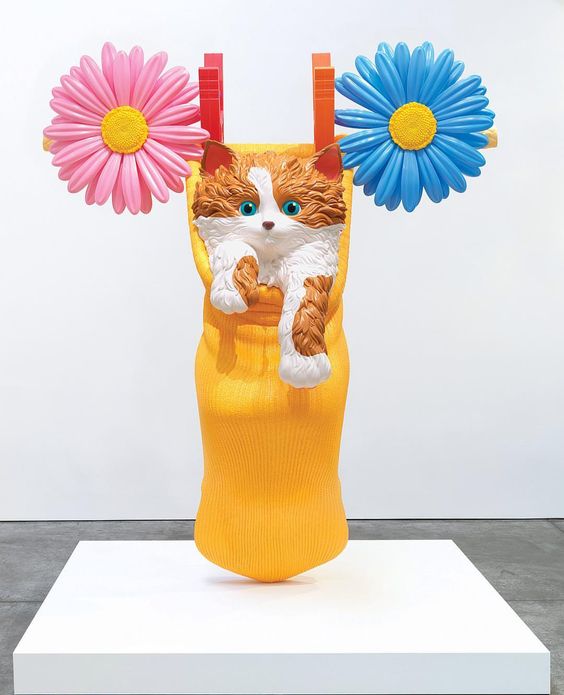





Whether or not you like Jeff Koons you can’t pass in front of his art indifferently. You wouldn’t see it in this photo but his Cat on a Clothesline is gigantic, it measures 312.4 x 279.4 x 127 cm. For Koons, this piece of art is “like a contemporary crucifixion. But it’s also this cute little cat, that’s just in a sock. You can also think of it as a womb-like situation, feeling that sense of protection”. You need to decide for yourself what it is to you.
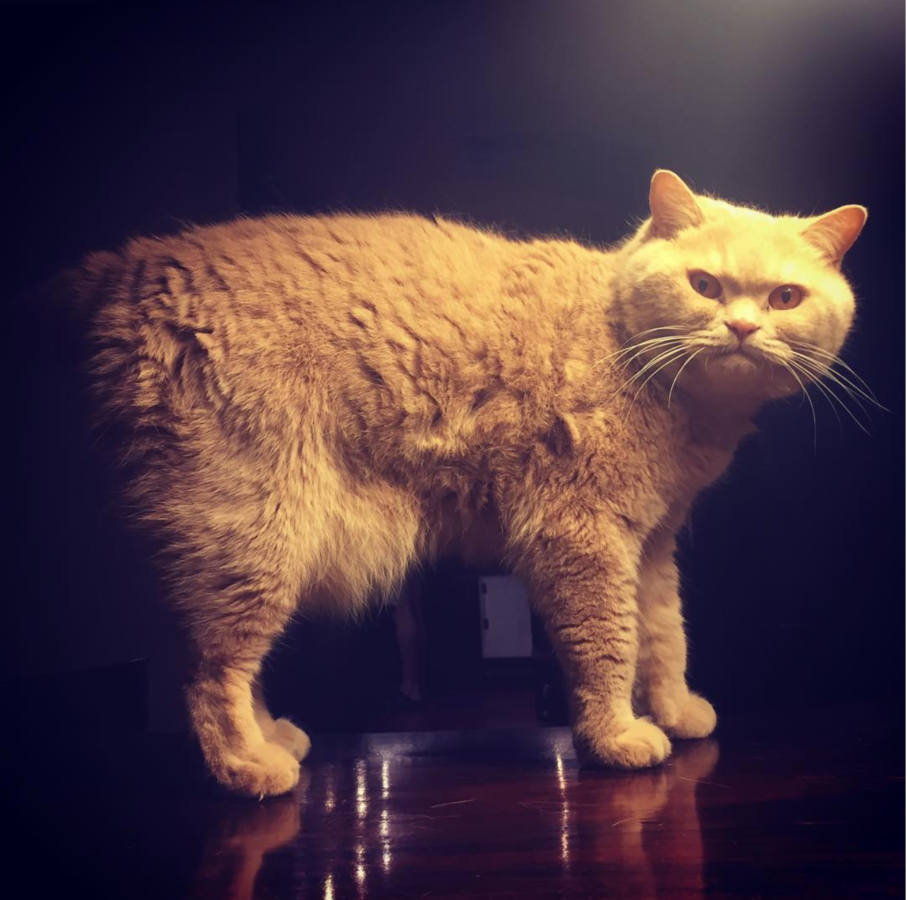





Last but not least… Here is Pimpa, the great supporter of DailyArt. I wish one of the great Dutch masters of the Golden Age could have done his portrait! Or at least Hieronymus Bosch would do it OK as well. Anyways, after all these fantastic examples of cats in art history, I just had to show you my cat.
DailyArt Magazine needs your support. Every contribution, however big or small, is very valuable for our future. Thanks to it, we will be able to sustain and grow the Magazine. Thank you for your help!